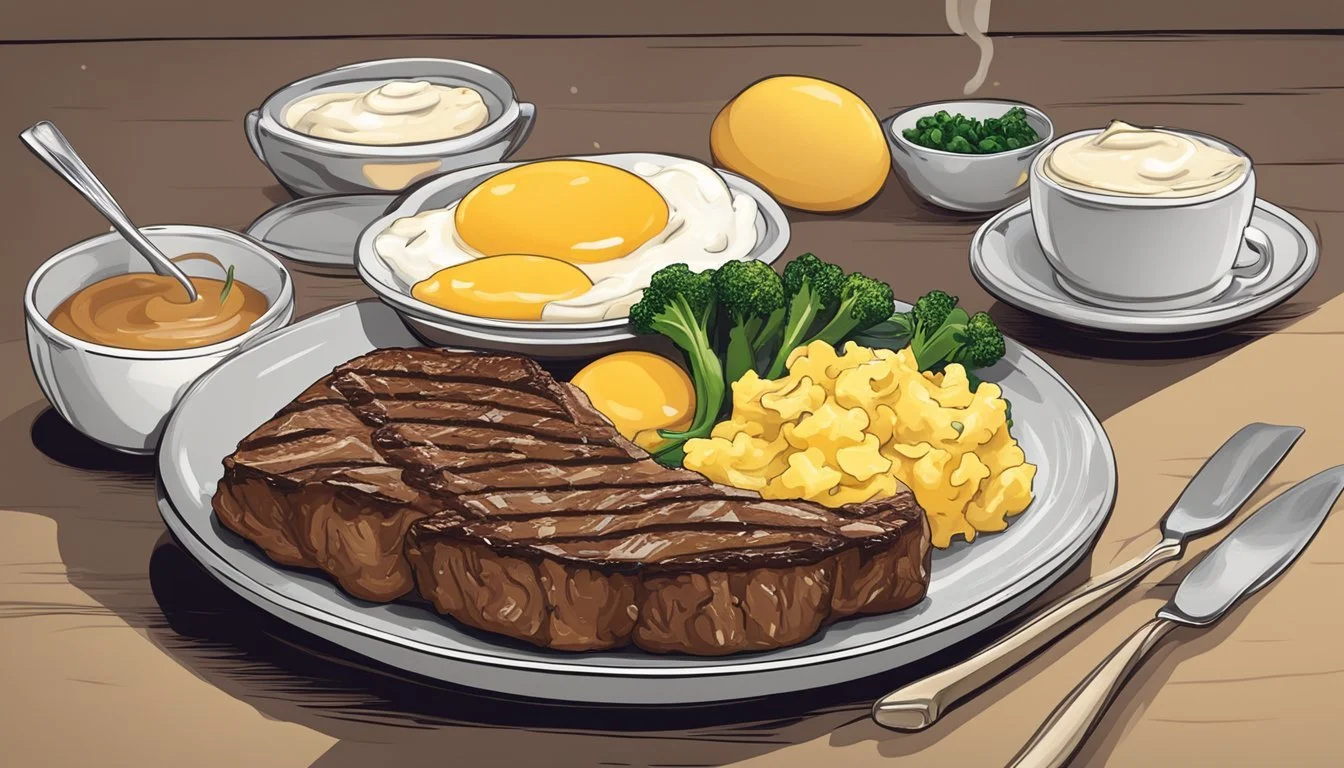Carnivore Diet and the Impact on Chronic Venous Insufficiency
Evaluating Vascular Health Outcomes
The impact of dietary choices on various health conditions has been an area of considerable research, and the focus on how diet affects chronic venous insufficiency (CVI) is gaining attention. CVI is a medical condition where the veins, primarily in the legs, fail to efficiently return blood to the heart, leading to symptoms such as pain, swelling, and in severe cases, ulcers. The carnivore diet, an eating regime consisting solely of animal products, is believed by some to offer health benefits, yet its implications on venous health are not universally agreed upon and warrant a closer examination.
Clinical evidence highlights the importance of a balanced diet in maintaining vascular health, yet the carnivore diet's restriction to exclusively animal-based foods raises questions about its long-term impact on the body's venous system. Supporters of this diet argue for its potential anti-inflammatory effects, which could theoretically benefit conditions like chronic venous insufficiency. However, the high protein and fat intake typical of a carnivore diet might influence venous pressure and functioning, possibly affecting venous insufficiency in ways that are not yet fully understood.
Considering that chronic venous insufficiency is a condition that can significantly affect an individual's quality of life, understanding the role of diet in managing or exacerbating this condition is vital. Research into the relationship between a carnivore diet and venous health is still in early stages, and more clinical studies are needed to draw definitive conclusions. As such, individuals with CVI or those at risk are advised to consult healthcare professionals before making significant dietary changes that might impact their venous health.
Understanding Chronic Venous Insufficiency
Chronic Venous Insufficiency (CVI) is a common and significant medical condition characterized by poor blood flow in the veins, prominently affecting the lower limbs. This section explores its definition, prevalence, causative factors, symptoms, and diagnostic criteria.
Definition and Epidemiology
Chronic Venous Disease (CVD) encompasses a range of disorders that impair venous return. The term "Chronic Venous Insufficiency" (CVI) describes the advanced stage of CVD, characterized by venous hypertension and blood flow disturbances in the lower extremities. It is estimated that up to 40 percent of people in the United States experience venous insufficiency to some degree, reflecting a substantial epidemiological impact.
Anatomical and Etiological Factors
CVI is primarily caused by venous reflux (the backward flow of blood) or venous obstruction. These disturbances can arise from anatomical defects, thrombosis, or valve insufficiencies within the venous system. Risk factors include age, family history of venous disease, obesity, pregnancy, and history of deep vein thrombosis (DVT).
Symptoms and Complications
Patients with CVI may experience a multitude of symptoms including:
Edema: Swelling of the lower limbs.
Pain: Ranging from a dull ache to acute discomfort.
Varicose Veins: Dilated, bulging veins.
Ulceration: Skin changes and ulcer formation, often indicated as C6 in the CEAP classification.
Chronic Venous Insufficiency can lead to serious complications if untreated, such as chronic pain, severe edema, and skin changes including ulceration.
Clinical Classification and Diagnosis
The CEAP classification (Clinical-Etiological-Anatomical-Pathophysiological) is a standardized system used to classify venous disorders. It ranges from C0, indicating no visible signs of venous disease, to C6, which indicates the presence of an active venous ulcer. Diagnosis typically involves a physical examination and ultrasound imaging to assess the anatomy of the veins, blood flow, and the presence of venous reflux.
Assessment of the Carnivore Diet
This assessment focuses on the composition, nutritional content, and potential impacts on health of the carnivore diet, with an emphasis on venous health.
Diet Composition and Nutritional Content
The carnivore diet is typically high in protein and fat, with a notable absence of carbohydrates. It mainly consists of meat, fish, eggs, and specific dairy products, which provide essential micronutrients and vitamins such as B12, D, and zinc. However, it lacks certain nutrients often found in plants, such as fiber and certain vitamins and minerals.
Discover the endless possibilities of buying fiber supplement, online!
Potential Benefits and Risks
Potential benefits of the carnivore diet may include weight loss, which can lead to a reduction in Body Mass Index (BMI), and in turn, potentially ameliorate symptoms associated with obesity. However, risks include increased cardiovascular disease due to high saturated fat consumption, hypertension, and an imbalance of essential nutrients, which may contribute to deficiencies. The long-term health outcomes of this diet are still under study, making it difficult to fully endorse its safety or efficacy for preventing or treating chronic conditions like diabetes.
Impact on Venous Health
Chronic venous insufficiency is a condition characterized by poor blood flow in the veins, resulting in swelling and discomfort. While there is no direct evidence linking the carnivore diet to improvements or deterioration in venous health, its influence on factors like obesity, hypertension, and blood pressure can indirectly affect venous conditions. Maintenance of a healthy weight and blood pressure are common treatment strategies for venous issues, and so the diet's effect on these factors is significant. Nevertheless, without specific studies on the carnivore diet's impact on venous health, assertions must be made with caution.
Impact of Diet on Chronic Venous Insufficiency
Diet plays a significant role in managing Chronic Venous Insufficiency (CVI), as it can influence symptoms like edema and ulcers. Specific nutrients affect venous health, and dietary choices can impact the effectiveness of treatments such as compression stockings and sclerotherapy.
Role of Nutrients in Venous Health
A balanced diet rich in dietary fiber, vitamins, and potassium is crucial for maintaining venous health. Dietary fiber helps prevent constipation, which can exacerbate venous insufficiency by increasing venous pressure. Adequate intake of vitamins, particularly vitamin C and flavonoids, supports the integrity of the venous wall and promotes wound healing.
Foods high in potassium may help to reduce water retention, thereby alleviating edema associated with CVI. Staying well-hydrated by consuming enough water is also essential for maintaining proper blood volume and pressure, which supports venous function.
Influence of Diet on Symptoms and Treatment
Diet can directly influence the symptoms of CVI and the effectiveness of treatments. For instance, an overweight or obese individual is more likely to experience exacerbation in their symptoms due to the additional pressure on their veins. Implementing a nutritious, well-balanced diet can assist in weight loss, which in turn can decrease the severity of symptoms such as ulcers and edema.
For individuals with CVI, treatment often includes compression stockings and potentially sclerotherapy. Maintaining a healthy diet supports these treatments by helping to manage overall venous pressure and reducing inflammation. It is also beneficial to avoid foods that are high in salt and trans fats, as they can contribute to fluid retention and further strain the venous system.
Lifestyle Considerations and Complementary Treatments
Managing chronic venous insufficiency involves more than medical treatments; it encompasses a holistic approach that includes lifestyle adjustments and complementary practices to mitigate symptoms and improve venous health.
Exercise and Physical Activity
Regular exercise can notably improve blood flow and vein strength, which is critical for managing varicose veins and preventing leg ulcers. Low-impact activities such as walking, swimming, and cycling are beneficial as they help promote circulation without putting excessive pressure on the veins.
Recommended Activities:
Walking: at least 30 minutes daily
Swimming: several times a week
Cycling: moderate intensity regularly
Weight Management and Smoking Cessation
Maintaining an optimal body weight reduces pressure on the veins and can alleviate the symptoms of venous insufficiency. Obesity is a significant risk factor for varicose veins due to the added stress on the circulatory system. Smoking cessation is also crucial as smoking contributes to poor blood flow and damages vascular health.
Body Mass Index (BMI): Aim for a BMI within the healthy range (18.5-24.9)
Influences on Quality of Life:
Overweight: Increased risk of vein problems
Smoking: Leads to deterioration of blood vessel walls
Compression Therapy and Vascular Procedures
Compression therapy using stockings or bandages is a foundational treatment for chronic venous insufficiency. It can reduce swelling, pain, and the risk of leg ulcers by enhancing blood flow. For more severe cases, vascular procedures such as endovenous ablation can be effective in closing off dysfunctional veins and improving blood circulation.
Compression Stockings:
Pressure Levels: 20-30 mmHg usually recommended
Usage: Daily wear is ideal for symptom management
Vascular Procedures:
Endovenous Ablation: Minimally invasive; uses heat or laser therapy to close veins
Clinical Research and Evidence
The connection between the carnivore diet and chronic venous insufficiency has been evaluated through a range of clinical research efforts, focusing on treatment outcomes and the subsequent impact on patients' quality of life.
Studies on Carnivore Diet and Venous Diseases
Epidemiological data suggests that dietary patterns may influence the progression of venous diseases. However, direct studies that assess the impact of a carnivore diet, which is rich in meat and animal products, on venous insufficiency are scarce. Initial research indicates that high intake of saturated fat might exacerbate the symptoms of chronic venous disease (CVD), such as leg ulcers and pain, due to increased inflammation and vascular dysfunction. Studies with statistical significance are necessary to draw a definitive conclusion regarding the role of carnivore diets in the development of venous diseases.
Treatment Outcomes and Quality of Life Measures
Treatment regimens for chronic venous insufficiency often include lifestyle and dietary modifications. Treatment outcomes are measured not only by clinical criteria but also by assessments of quality of life. Clinical trials adopting these measures have found that diets low in inflammatory foods may alleviate symptoms of CVD, such as edema and pain, potentially leading to improved patient quality of life. However, the absence of large-scale studies specifically investigating the carnivore diet's impacts on these outcomes highlights an area in need of further clinical research to provide concrete evidence for guiding treatment protocols.
Societal and Healthcare Perspectives
This section addresses the intersection of Chronic Venous Insufficiency (CVI) with healthcare systems in terms of economic impact, and public health initiatives including policy and screening.
Economic Burden on Healthcare Systems
Chronic Venous Insufficiency imposes a significant economic burden on healthcare systems globally. Management of CVI often involves long-term treatment and follow-up, which can include the use of compression therapy, medications, and potentially surgery. Costs arise not only from direct care but also from indirect factors such as:
Workforce absenteeism
Reduced productivity
Long-term disability
Financial pressures are compounded in cases where complications occur, such as venous ulcers requiring specialized treatment. Healthcare systems must account for both the immediate and ongoing expenses related to the care of patients with CVI.
Public Health Policies and Screening Programs
Public health policies play a crucial role in addressing CVI. By implementing screening programs aimed at early detection, healthcare systems can help mitigate the long-term impact of the disease. Effective screening can lead to:
Early diagnosis: Reducing the severity of progression
Preventative strategies: Educating individuals on lifestyle modifications
Cost savings: Lessening the financial burden on the healthcare system by avoiding costly complications
Such public health initiatives require collaboration between healthcare providers, policymakers, and the community to promote awareness and incorporate CVI screening into routine health assessments. These efforts are essential in reducing the prevalence and severity of CVi in the population.








